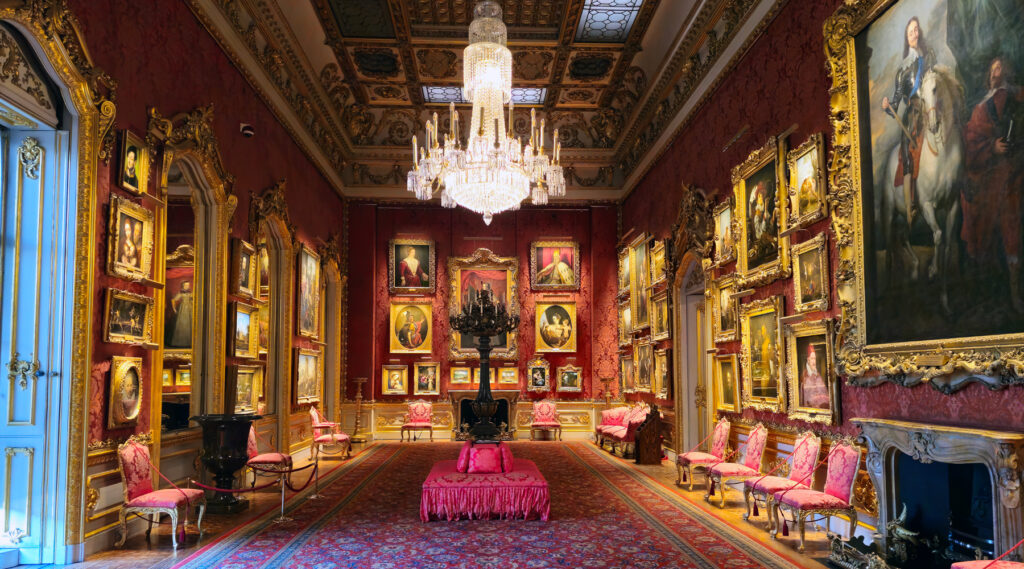The Duke of Wellington is famous for the vast number of portraits of him in his military uniforms, but the actual uniforms themselves were hardly ever seen in public – until now.
Five of his formal dress uniforms have gone on display in his London home. Two haven’t been on display for about 50 years, and three have never been seen in public before. So, for most people, it’s pretty much the first time that they’ve been able to see any of the five dress uniforms on show inside Apsley House, the ancestral home of the Dukes of Wellington.
Apart from the uniforms going on display, the other major change is that you can now take photos of the house. Until just a few weeks ago, photography inside the house was forbidden, but they’ve bowed to the inevitable and you can now share your photos of the richly decorated interior.
The official uniforms and opulent staterooms are a far cry from the man himself, for though he was quite patrician politically, he was quite modest in person and rarely made use of the grandeur a man of his standing was expected to enjoy. In fact, his private rooms upstairs, still occupied by the current Duke, were notably basic and were said to feel closer to the tents he would have slept in as a military commander than a ducal manor.
Back to the uniforms, in recognition of his military victories in the Napoleonic Wars, Wellington was awarded the highest military rank of Field Marshal, or its equivalent, in eight nations’ armies.
Four of the uniforms on display represent his appointments as Marshal-General of the Portuguese Army (1809), Captain-General of the Spanish Army (1809), Field Marshal of the British Army (1813) and Field Marshal of the Austrian Army (1818).
The fifth uniform is that of Colonel of the Grenadier Guards (1827), the most senior infantry regiment in the British army.
As the Duke, he was often painted in one of the various dress uniforms, although the exhibition curator, Dr Olivia Fryman, confirmed to me that many of the portraits would have been copied from another one, as the Duke loathed sitting for the hours needed to be painted.
Quite a few of the portraits are dotted around Apsley House, and you can almost play a game of spotting which uniform on display is in each portrait. I’d also recommend picking up the guidebook next to the display of the uniforms as that explains which is which and the details of the decoration in the uniforms.
And now, you can also take photos of the exceptionally richly decorated interior — well, of the grand state rooms, as His Grace’s private apartments are off-limits to visitors.
Apart from all the grandeur you’d expect, there are also flashes of modernity in this ancestral home. The current duke commissioned a striking artwork by Michael Craig-Martin RA in 2014, based on the famous portrait of the 1st Duke by Sir Thomas Lawrence — which you can also see upstairs.
Probably one of the more famous objects, though, is the massive marble sculpture of Napoleon—shown (almost) naked in the guise of Mars the Peacemaker—and describing Napoleon as a peacemaker is rather akin to awarding the Nobel Peace Prize to Vladimir Putin.
Napoleon commissioned the massive statue, although he disliked the end product and banned anyone from seeing it. Following his defeat at Waterloo in 1815, the statue was sold to the British government in 1816, and gifted to the Duke in 1817. I’ve occasionally wondered what Napoleon thought if he learned a statue of himself now resided in the Duke of Wellington’s home.
Also on the ground floor is the “museum room”, which is filled with the sort of military and grand house memorabilia you would expect but is dominated by an impressive model of an Egyptian temple, which fills most of the length of the room.
This year also marks the 20th anniversary of English Heritage taking over the running of Apsley House. It was gifted to the nation in 1947, with the proviso that the Duke would retain the private accommodation while the V&A looked after the staterooms. However, disagreements between the late Duke and the V&A from the 1990s onwards culminated in the management being handed to English Heritage in 2004.
Today, you can visit Apsley House, and if you’re a member of English Heritage then that visit will be free of charge.
If you’re not, then admission is £12.50 for adults if booked in advance — slightly more on the door.



















Leave a Reply